SOP for Swachh Office
SOP for Swachh Office
The Standard Operating Procedures (SOP) for 'Swachh Office' released by the Ministry of Urban Development, Government of India lays out the infrastructure norms, assessment and inspection procedures and checklists, and sanitation and waste management best practices to be followed in offices.
Objectives
- The SOP are set out in a detailed format to cover the issues required to implement proper cleaning of government offices.
- A significant objective of the SOP is to improve the rating of office buildings on the ‘Swachh Office’ ratings which are undertaken as part of thematic drives every year.
- The purpose of the SOP is to improve current cleanliness levels in the Government of India offices. The primary way to achieve the same is through inculcating good sanitation and hygiene practices in employees and visitors.
- The SOP also targets to eliminate the need for multiple tendering for the same purpose across all Ministries and Departments, ensure quality of products at reasonable rates and their ensured supply, ensure proper waste management through recycling and processing of waste, and establish systems in office for cleanliness.
Important points to note
- All staff are responsible for the cleanliness of the office premises.
- The Standard Operating Procedures for Cleanliness in Government Buildings provides detailed best practice guidelines for all aspects of cleaning in government offices.
- All Government of India Offices should comply with the guidelines set out in the Standard Operating Procedures.
- The concept of Shramdaam to be indoctrinated in Government employees.
Scope
- This SOP for ‘Swachh Office’ is applicable to all offices under the Central Government, across India.
- This SOP may also be utilized by various state and local governments for their offices
Responsibilities
Overall Responsibility
- The specific Ministry/Department/Government Body/Government Agency is responsible for ensuring compliance to the SOP for their office premises. In the case of shared premises for more than one Government Body, the responsibility lies with all the bodies, irrespective of the amount of space utilised by either.
- A Sanitation Committee (under the chairmanship of relevant JS (Admin)) should be setup to monitor and supervise the works being carried out by the responsible party (Administration/Contracted Agency) and ensure compliance to the SOP. Identification of personnel within the Ministry/Department/Government Body along with their roles and responsibilities should be carefully laid out. Apart from officials at senior positions, lower level staff should also be part of the committee.
- The committee should also ensure compliance to infrastructure requirements as laid out in this SOP. Further, in case of contracting an external agency to carry out the cleanliness works, Service Level Agreements should be drafted and signed by both parties.
Responsibilities of the Administration /Contracted Agency
It is the responsibility of the Administration/ Contracted Agency for carrying out the Housekeeping of the office premises on a regular basis and comply with the fol lowing guidelines:
- Ensure a clean environment for its staff through proper selection of agencies required for the job.
- Regular surprise inspection of the premises to ensure compliance with the SOP.
- Attain and maintain high standards of cleanliness and general upkeep.
- Train, control and supervise staff under its establishment.
- Attain good relations with other departments.
- Ensure safety and security of all staff under its department and to keep superior authorities informed about day to day activities
- Control and issue of cleaning materials and equipment.
- Maintain official records on staffing, cleaning materials and equipment.
- Cleaning standards, frequency and accountability for cleaning are clearly defined (i.e., who cleans, what and how do they clean and when do they clean it).
- Cleaning schedules ensure that no area is missed from routine cleaning.
- Statutory requirements are met in relation to ;
- Waste Management ; Environment Protection Act ; Food hygiene ; Pest control
Inspection
Daily Inspection
| To be conducted by : Direct Supervisor | |
| Sr.No | Area & Activity |
| 1 | Check if All blocks, Open area and reception area have been swept and waste removed appropriately. |
| 2 | Check if all Dustbins have been emptied and cleaned. |
| 3 | Check if Cleaning, Sweeping & Mopping of floors with Disinfectant cleaner of all the floors including staircases and all the rooms/halls has been done. |
| 4 | Check if cleaning, Sweeping & Mopping of common areas has been done. |
| 5 | Check doors, windows, window glass and grills, window panes, furniture, fixtures, venetian blinds, window edges for cleanliness. |
| 6 | Check if there are any Stains, Spills, foot marks on floor |
| 7 | Check if Reception area has been swept, mopped and dusted. |
| 8 | Check if toilets are clean and dry. |
| 9 | Check working of exhaust fans |
| 10 | Check Stair case cleaning, sweeping & mopping |
| 11 | Change/check of toilets papers/ napkins |
| 12 | Check if waste papers and any other garbage and blockage and choking from the entire area covered has been removed appropriately |
| 13 | Check for cleaning of baskets, wastepaper baskets, cobwebs and disposing off all collected refuse at designated site. |
| 14 | Check if cleaning and scrubbing of toilets, wash basins, sanitary fittings, glasses & mirrors and toilets floors has been done |
| 15 | Check if cleaning and disinfecting all vitreous fixtures including toilet bowls, urinals, sinks, toilet seats, containers etc. has been done properly Check below water level and under rims including areas at hinges and cistern handles. Check if restock of toiletries, including Liquid hand soap, Toilet paper, air freshener, and Sanitary Cubes and Naphthalene balls in toilets has been done |
| 16 | Check if hairs, dust, dirt or any such object are present. |
| 17 | Check if cleaning, sweeping, dusting, mopping, scrubbing of canteen, reception, security rooms, committee room, conference room has been done. Meeting rooms should be checked at regular intervals during the day especially after each meeting). |
| 18 | Check if waste has been removed from office premises. |
| 19 | Check if one Housekeeping personnel is present in front of every toilet. |
Weekly Inspection
| To be conducted by : Representative of Sanitary Committee (by turns) | |
| Sr.No | Area & Activity |
| 1 | Check all daily reports since past week for compliance. Check all items as outlined in daily inspection report during weekly inspection as well. |
| 2 | Check past 3 weekly reports for areas identified for improvement/ corrections and check if the same have been addressed. |
| 3 | Check if cleaning of partitions/cubical etc. has been done. |
| 4 | Check if stains identified during daily/ past weekly inspections have been removed. Check for any new stains and ask for it to be removed. |
| 5 | Check for cleaning of electrical fittings |
| 6 | Check for polishing and grinding with rubber thread of floor areas |
| 7 | Check for cleaning of all chrome fittings, glass frames, soap holders etc. to a shiny finish |
Monthly Inspection
| To be conducted by : JS (Admin) or equivalent |
|
| Sr.No | Area & Activity |
| 1 | Check all daily and weekly reports since last month for compliance. Check all items as outlined in daily and weekly inspection report during monthly inspection as well. |
| 2 | Check past 3 monthly reports for areas identified for improvement/ corrections and check if the same have been addressed. |
| 3 | Conduct self-evaluation as per parameters of ‘Ranking of Government Offices’ done by MoUD (outlined previously here). Identify areas of improvement and delineate action items. |
| 4 | Conduct infrastructure gap assessment (as outline previously in this document) and identify action items (can be done quarterly as well, depending on need). |
| 5 | Check areas under construction (if any) and confirm that there is no undue collection of debris and C&D waste. |
| 6 | Check all major infrastructural items and fittings to ensure they are in good condition. |
| 7 | Check roster/daily register of housekeeping staff to see that the deployment is adequate and timely |
| 8 | May want to conduct impromptu interviews with employees, Heads of Departments for identifying improvement areas. |
Infrastructure Set-Up
The requirements for fitments for drainage and sanitation in case of office buildings shall comply with the requirements of Indian Standards IS 1172:1993 (Reaffirmed 2007).
Water Requirement
All premises shall be provided with the supply of clean water (with adequate provision of potable water), and shall ensure it is not connected with unsafe water subject to the hazards of backflow or back siphonage. Water requirement for office buildings is specified at 45 liters per head per day.
Drainage
Adequate arrangements shall be made for satisfactory drainage of all sewage and waste water. The drainage shall be so designed as to cause no stagnation at the maximum discharge rate for which the different units are designed.
Sanitary infrastructure requirements for office premises
| S. No | Fitments | For Male Personnel | For Female Personnel |
| 1 | Water Closets# | 1 for every 25 persons or part thereof | 1 for every 15 persons or part thereof |
| 2 | Ablution Taps | 1 in each water closet | 1 in each water closet |
| 1 water tap with draining arrangements shall be provided for every 50 persons or part thereof in the vicinity of water closet and urinals | |||
| 3 | Urinals |
• Nil upto 6 persons • 1 for 7 - 20 persons • 2 for 21 - 45 persons • 3 for 46 - 70 persons • 4 for 71 - 100 persons • From 101 - 200 persons, add at the rate of 3 per cent • For over 200 persons, add at the rate of 2.5 per cent |
N.A |
| 4 | Wash Basins | 1 for every 25 persons or part thereof | |
| 5 | Drinking Water fountains | 1 for every 100 persons with a minimum of one on each floor | |
| 6 | Cleaner’s sink | Minimum of 1 per floor, preferably in or adjacent to sanitary rooms | |
| # This may include adequate number of European style water - closets if desired. | |||
Waste Management
A strategy needs to be in place to ensure proper management of waste generated and reduction of waste through recycling and reusing.
Types of waste generated
- Bio-degradable (dry) waste {green waste, food waste, paper waste, biodegradable plastics}
- Hazardous waste,
- Construction and demolition waste,
- Bulk garden and horticulture waste including recyclable tree trimmings,
- All other non-biodegradable (dry) waste {recyclable and non-recyclable}
Management of Waste
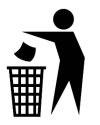 Bio-degradable Solid Waste if not composted by the generator, shall be stored by generators of such waste within their premises and its delivery shall be ensured by every such generator to the Municipal Vehicle or to the bio-degradable waste collection vehicle provided for specified commercial generators of bulk bio-degradable waste. Local composting of waste shall be promoted to minimize transportation of waste. The Municipal body shall collect the bio degradable waste from inside the office complex keeping with their duties of door to door collection (for example the NDMC does not periodically collect waste from the office and the dumpers outside get full quickly and hence waste overflows. Since NDMC has local waste processing facilities, hence they should be proactive to collect such waste from office complexes).
Bio-degradable Solid Waste if not composted by the generator, shall be stored by generators of such waste within their premises and its delivery shall be ensured by every such generator to the Municipal Vehicle or to the bio-degradable waste collection vehicle provided for specified commercial generators of bulk bio-degradable waste. Local composting of waste shall be promoted to minimize transportation of waste. The Municipal body shall collect the bio degradable waste from inside the office complex keeping with their duties of door to door collection (for example the NDMC does not periodically collect waste from the office and the dumpers outside get full quickly and hence waste overflows. Since NDMC has local waste processing facilities, hence they should be proactive to collect such waste from office complexes).- Hazardous Waste shall be scientifically disposed as per Municipal Solid Waste Management norms. Good management practice should ensure that hazardous wastes are stored, collected, transported and disposed of separately, preferably after suitable treatment to render them innocuous.
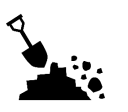 Construction and Demolition Waste shall be stored only within the premises of buildings, or in containers where such facility of renting out containers is available, till finally removed from the premises. No person shall dispose of construction waste or debris on the streets, public spaces, footpaths or pavements. If contractors have the obligation to collect the C&D waste, it should be done immediately after all work is finished. Failure to do so will attract penalty (for example CPWD does not pick up the waste on time and leaves the unused cement bags etc. lying for months. As a result the C&D waste gets spread around. While, in normal course, all the waste is picked up together, but it should also be done in piecemeal manner).
Construction and Demolition Waste shall be stored only within the premises of buildings, or in containers where such facility of renting out containers is available, till finally removed from the premises. No person shall dispose of construction waste or debris on the streets, public spaces, footpaths or pavements. If contractors have the obligation to collect the C&D waste, it should be done immediately after all work is finished. Failure to do so will attract penalty (for example CPWD does not pick up the waste on time and leaves the unused cement bags etc. lying for months. As a result the C&D waste gets spread around. While, in normal course, all the waste is picked up together, but it should also be done in piecemeal manner).- Bulk garden and horticultural waste shall be kept un-mixed and composted at source. The Director (Horticulture) or the concerned officer shall notify Instructions/ guidelines with regard to pruning of trees and storage and delivery of tree trimmings including collection schedules.
- All other Non-biodegradable (“Dry”) waste – both recyclable and non-recyclable – shall be stored and delivered by every generator of waste to the dry waste collection vehicle.
- Burning of waste: Disposal by burning of any type of solid waste is prohibited.
- The Administration/Contracted Agency must ensure that officials do not throw any waste on the streets, footpaths, open spaces, drains or water bodies and instead store the waste at source of waste generation in two bins/bags, one for food waste/biodegradable waste and another for recyclable waste such as papers, plastic, metal, glass, rags etc.( as under):-
- Food wastes of all kinds, cooked and uncooked, including eggshells, bones.
- Flower and fruit wastes including juice peels and house-plant wastes.
- House sweepings (not garden sweepings or yard waste: dispose on-site)
- Household Inert (sweepings/ashes)
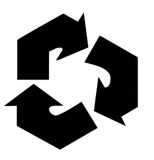 Paper and plastic, all kinds
Paper and plastic, all kinds- Cardboard and cartons
- Containers of all kinds excluding those containing hazardous material
- Packaging of all kinds
- Glass, all kinds
- Metals, all kinds
- Rags, rubber, wood
- Foils, wrappings, pouches, sachets and tetrapaks (rinsed)
- Cassettes, computer diskettes, printer cartridges and electronic parts
- Discarded clothing, furniture and equipment
A) Types of Wastes to be put in the Bin Meant for Food Wastes & Bio-degradable Wastes
B) Types of Recyclable and Other Non-Bio-degradable Wastes to be Kept Separately:
C) Wastes such as used batteries, containers for chemicals and pesticides, discarded medicines and other toxic or hazardous household waste (as under), if and when produced, should be kept separately from the above two streams of waste.
Solid Waste Management Infrastructure
Waste containers
These need to be planned according to its usages and can be in following categories:
- Community Waste Containers – size 1000-1500ltrs
- Individual waste containers – size 50 – 100Ltrs
- Kerb side recycling bins - size 30-50Ltrs
- Paper bins (Under table bins) - size 10-15Ltrs For easy identification colour coding is also must as indicated below.
The local authority can choose the colour as per their choice of interest.
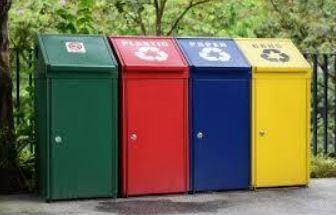
Food waste disposer
Food waste disposers are easily installed and eliminate the need to store biodegradable kitchen waste on the premises; they can deal with 15 % to 20 % (by weight) of the total average output of household waste. They are a complimentary tool to methods of waste storage and collection. The units are designed to grind biodegradable kitchen waste in a safe, clean and efficient manner to tiny particles by the food disposer’s shredding blades. When a small amount of water is run into the disposer, the remaining particles of material are easily flushed down the drain into the sewerage system or septic tank.
Food waste disposers enable segregation of waste types at source, without which recycling of different types of waste is not possible. The potential for hygienic collection and recycling of various dry recyclables such as paper, glass and metals is increased with the reduction of contamination of food waste.
Shredder
Used for volume reduction of specific wastes that are capable of being slit by rotating knife blades. Typical wastes that can be shredded are cans, plastic bottles, steel barrels, tyres, etc. In addition, confidential papers may also be shredded but not for the purpose of volume reduction.
Shredding of steel barrels, tyres and other large objects is normally carried out at purpose-built facilities, which fall outside the scope of this code of practice. A shredder require es an electrical power source and should be sited to provide convenient and safe feeding of the waste.
The shredded waste will be collected in suitably sized containers situated under the shredder, which can be removed manually.
Better practice strategies
- Strategies used in better practice systems include:
- Providing clear signs in the bin rooms and consistent wording, symbols and colours on all bins.
- Providing clean bins and bin rooms that are free of dumped and undisposed waste.
- Dirty and untidy waste facilities indicate that building management does not care and tenants will then fail to use facilities correctly
- Closed-circuit television (CCTV) monitoring of waste rooms and bin storage areas
- Including terms in lease agreements outlining and enforcing proper use of the waste facilities
- Training of all management and tenant staff in the use of the waste system and any equipment
- Repairing signs, labels, bins and equipment and promptly replacing damaged equipment using the same designs
- Changing all waste and recycling signs if there are changes in corporate designs, colours or look – a mix of new and old signs and labels is unacceptable
- Installing swipe cards, or other electronic access control devices to be used by tenants to access the bin room or waste management equipment
- Regular monitoring by building management on all parts of the waste system, including the bins, bin storage areas and equipment as well as tenant and cleaner behaviour for misuse, contamination of recycling, damage, dumped rubbish and other problems including terms in cleaning contracts that set out what cleaners must do to keep the waste system and equipment in good order
- Providing a collection service for waste and recycling to avoid the need for tenant staff to use the waste rooms.
Cleaning Practices
All corridors, rooms, toilets and external areas of the office building including flooring, ceiling, furniture, doors, windows, fixtures, etc. should be clean at any given time. The following cleaning routine should be adhered to:
Sweeping and Mopping of floor
 Sweeping of corridors with disinfectant at least once a day.
Sweeping of corridors with disinfectant at least once a day. - Place appropriate warning signage to avoid accidents.
- Frequent brooming of the corridor through the course of the day.
- Vacuum cleaning of carpets atleast daily using appropriate vacuum cleaning equipment.
Garbage Bins
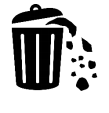 Remove garbage from dustbins and clean them if required.
Remove garbage from dustbins and clean them if required. - Provide separate dustbins for biodegradable and non-biodegradable materials.
- Replace the cleared dustbins to the original spot.
- If any trash found on the lobby area then pick up immediately. Doors,
Windows and Walls
 Spray windows and glass surfaces with water or appropriate cleaning solution.
Spray windows and glass surfaces with water or appropriate cleaning solution. - Removal of all cobwebs and stains.
- Extensive cleaning of outer-surface of windows to be carried out by contracted agency at least once a month.
- If any fingerprints, smudges or stains found on the corridor wall then the same to be cleaned immediately.
Vents and Fixtures
 Dusting of light fittings, wall decorations, other fixtures using feather brush and duster.
Dusting of light fittings, wall decorations, other fixtures using feather brush and duster. - Air conditioning vents and sprinklers should also be dusted and checked for proper functioning.
Toilets
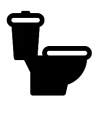 Fixtures including toilets and sinks are free of streaks, soil and stains and soap scum.
Fixtures including toilets and sinks are free of streaks, soil and stains and soap scum. - Mirrors and windows are free of dust and streaks.
- Dispensers are free of dust, soiling and residue and replaced/replenished when empty.
- Waste is disposed of appropriately on a daily basis.
- Provisioning of soap, toilet paper, hand towel/dryer, sanitary pads dispenser, dustbins, and other necessary items.
- Toilet bowls, urinals and adjoining areas should be cleaned with disinfectant on a daily basis, and the use of acid-based disinfectants should be avoided.
- Toilet floors should be kept dry to the extent possible/feasible.
External Areas/ Open Spaces/ Common Spaces
 Sweeping of external areas at least twice daily.
Sweeping of external areas at least twice daily. - Provisioning of sufficient number of dustbins to prevent littering.
- Cleaning of garbage dumping site (if present within premises) monthly.
- Composting of leaves and biodegradable waste (if feasible).
An Intensive Cleaning of the entire office premises should be carried out at least once in two months which should also involve participation all officials and staff (through Shramdaan) for disposal of redundant/unused hardware, furniture which can be added to inventory and re-allocated as per demand. If necessary spot tendering to be practised to avoid delays and creation of space in the office.
For more Information Please click here
Source: Swachhbharat
Last Modified : 6/29/2024
This topic provides information about Additional S...
This topic provides information about Blue Revolut...
This topic contains the information related to De...
Bhasha Sangam initiative for schools and educatio...
